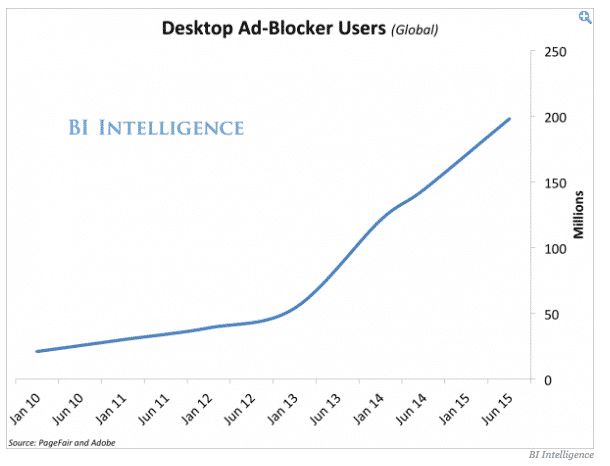
That’s 200 million people who may not see the advertisements you are creating and paying to show. This year alone ad blocking grew in popularity with a 44% increase of global users and that percentage will only increase as we go into 2016.
To help make sure your advertisements are actually being seen, let’s first tear apart the fundamentals of ad blocking.
What Exactly is Ad Blocking?
Ad blocking has been around for years and does exactly what it’s name implies: it blocks ads. The point of ad blocking is for users to be able to remove any and all advertisements from a web browser and visit pages freely, without having to see unwanted ads. This makes for a cleaner layout when reading articles online and helps improve the load time by saving the bandwidth needed to display ads. This also makes for an extremely difficult situation for advertisers, publishers, and media companies who make a majority of their revenue from displaying ads on web pages.
Ad blocking doesn’t just block advertisements, though. Content that is deemed intrusive or an invasion of privacy may also be blocked from web pages using content blockers on mobile. Buttons and sharing features can also be categorized as “annoying” from content blockers and be removed, which limit sharing options on mobile.
Does Ad Blocking Affect Publishers?
You bet your ad budget it does! This year alone, ad blocking is estimated to cost publishers almost $22 billion of revenue. First came print, then came online and with online came the struggle to make money from providing free online articles. Publishers have just barely figured out that battle and then got hit with ad blocking.
How Are Companies Handling Ad Blockers?
Ad blocking is extremely frustrating for publishers and advertisers. That’s why companies like Yahoo are taking a stand against ad blocking, at least to an extent. Since ad blocking is legal and meant to benefit user experience, publishers are having a difficult time persuading users to not use ad blocking.
Yahoo recently got creative and decided to tiptoe around this issue by banning users from email accounts if they use ad blockers. Yahoo, like Google, depend heavily on advertising for revenue and are able to offer free services like news articles and email accounts because of the revenue stream from advertising. Ad blocking not only complicates this stream, but is forcing companies like Yahoo to rethink their free services.
On November 23, Yahoo told the Washington Post that they were experimenting with this for a small number of Yahoo users as a “test”. Depending upon the results and reactions to the test, Yahoo may make this policy a norm.
How Does Ad Blocking Effect Mobile?
The mobile version of ad blocking is just as harmful to publishers and advertisers, especially with Apple’s latest update. Which is why Axel Springer, one of the largest digital publishing companies in Europe, is taking iOS 9’s newest ad blocking app “Blockr” to court. Blockr is an app that lets users block ads and other content that slows down web browsing on mobile. Axel Springer has gone to court to stop developmentation and distribution of the app and wants to prohibit Blockr from being able to block ads on mobile, especially from their website.
Whether or not Axel Springer wins their case, users can still download a variety of other ad blocking apps on their phones to block ads from appearing and help to increase web page load times. Faster load times, which use less bandwidth, help increase battery life and user experience when reading and searching online. The benefits for users using ad blocking is clear, but publishers are still struggling to adapt.
How Can Publishers Survive Ad Blocking?
Ad blocking has the potential to harm how the Internet works, but not just in an advertising sense. If ad blocking continues to cost billions in revenue it will eventually affect how free services are provided online, and if they continue to remain “free”.
While we see how ad blocking plays out in 2016, there are a few ways to get around ad blockers as long as you are willing to get creative.
- Design Less-Intrusive Ads. Advertisements are either helpful, entertaining, or downright annoying. Don’t choose the latter; design your advertisements to be helpful, attractive, and relevant to a user. People are less likely to want to block ads if they can relate directly to them.
- Tell a Story Using Ads. Get creative and tell a story with each ad, sending a direct message to your demographic. Try incorporating more video and animated elements to go along with the story and make the ad more engaging. Chipotle did a great job of this with their new app-based game that received over 15 million views on YouTube.
- Timing is Everything. Pop-up ads are so 2000. No one wants your advertisement to pop up as a new page loads or in between app activity on mobile. Time your ads to display at relevant times and in relevant locations. Conduct several A/B tests to see what type of placement and time your ads are most clicked on.
- Be Relevant. Why advertise a food magazine subscription on a gaming app? Do thorough research on your demographic and create advertisements tailored to their specific needs and likes. You can also experiment with finding hooks for your products to display ads on pages that may not be 100% connected, but have similar features you can draw from.
- Technology. Some marketing companies are looking into developing a tool that blocks ad blockers so advertisements can still be shown. This tactic can be risky, as it will upset users who clearly chose to remove advertisements. Still being able to see ads could cause several users to attack brands, but brands would be able to get their revenue streams back online.
Where do you stand with ad blocking? Comment your thoughts below!


